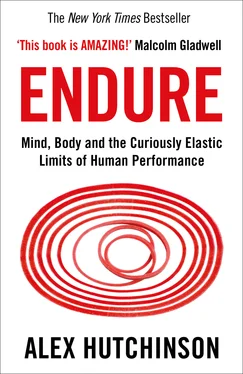Like many milers before me and since, I was a Bannister disciple, with a creased and nearly memorized copy of his autobiography in permanent residence on my bedside table; but in that winter of 1996 I was seeing more and more Landy when I looked in the mirror. Since the age of fifteen, I’d been pursuing my own, lesser four-minute barrier—for 1,500 meters, a race that’s about 17 seconds shorter than a mile. I ran 4:02 in high school, and then, like Landy, hit a wall, running similar times again and again over the next four years. Now, as a twenty-year-old junior at McGill University, I was starting to face the possibility that I’d squeezed out every second my body had to offer. During the long bus ride from Montreal to Sherbrooke, where my teammates and I were headed for a meaningless early-season race on one of the slowest tracks in Canada, I remember staring out the window into the swirling snow and wondering if my long-sought moment of Landyesque transformation would ever arrive.
The story we’d heard, possibly apocryphal, was that the job of designing the Sherbrooke indoor track had been assigned to the university’s engineering department as a student project. Tasked with calculating the optimal angles for a 200-meter track, they’d plugged in numbers corresponding to the centripetal acceleration experienced by world-class 200-meter sprinters—forgetting the key fact that some people might want to run more than one lap at a time. The result was more like a cycling velodrome than a running track, with banks so steep that even most sprinters couldn’t run in the outside lanes without tumbling inward. For middle-distance runners like me, even the inside lane was ankle-breakingly awkward; races longer than a mile had to be held on the warm-up loop around the inside of the track.
To break four minutes, I would need to execute a perfectly calibrated run, pacing each lap just two-tenths of a second faster than my best time of 4:01.7. Sherbrooke, with its amusement-park track and an absence of good competition, was not the place for this supreme effort, I decided. Instead, I would run as easily as possible and save my energy for the following week. Then, in the race before mine, I watched my teammate Tambra Dunn sprint fearlessly to an enormous early lead in the women’s 1,500, click off lap after metronomic lap all alone, and finish with a scorching personal best time that qualified her for the national collegiate championships. Suddenly my obsessive calculating and endless strategizing seemed ridiculous and overwrought. I was here to run a race; why not just run as hard as I could?
Reaching the “limits of endurance” is a concept that seems yawningly obvious, until you actually try to explain it. Had you asked me in 1996 what was holding me back from sub-four, I would have mumbled something about maximal heart rate, lung capacity, slow-twitch muscle fibers, lactic acid accumulation, and various other buzzwords I’d picked up from the running magazines I devoured. On closer examination, though, none of those explanations hold up. You can hit the wall with a heart rate well below max, modest lactate levels, and muscles that still twitch on demand. To their frustration, physiologists have found that the will to endure can’t be reliably tied to any single physiological variable.
Part of the challenge is that endurance is a conceptual Swiss Army knife. It’s what you need to finish a marathon; it’s also what enables you to keep your sanity during a cross-country flight crammed into the economy cabin with a flock of angry toddlers. The use of the word endurance in the latter case may seem metaphorical, but the distinction between physical and psychological endurance is actually less clear-cut than it appears. Think of Ernest Shackleton’s ill-fated Antarctic expedition, and the crew’s two-year struggle for survival after their ship, the Endurance, was crushed in the ice in 1915. Was it the toddlers-on-a-plane type of endurance that enabled them to persevere, or straightforward physical fortitude? Can you have one without the other?
A suitably versatile definition that I like, borrowing from researcher Samuele Marcora, is that endurance is “the struggle to continue against a mounting desire to stop.” That’s actually Marcora’s description of “effort” rather than endurance (a distinction we’ll explore further in Chapter 4), but it captures both the physical and mental aspects of endurance. What’s crucial is the need to override what your instincts are telling you to do (slow down, back off, give up), and the sense of elapsed time. Taking a punch without flinching requires self-control, but endurance implies something more sustained: holding your finger in the flame long enough to feel the heat; filling the unforgiving minute with sixty seconds’ worth of distance run.
The time that elapses can be seconds, or it can be years. During the 2015 National Basketball Association playoffs, LeBron James’s biggest foe was—with all due respect to Golden State defender Andre Iguodala—fatigue. He’d played 17,860 minutes in the preceding five seasons, more than 2,000 minutes ahead of anyone else in the league. In the semis, he surprisingly asked to be pulled from a game during a tense overtime period, changed his mind, drained a three-pointer followed by a running jumper with 12.8 seconds left to seal the victory, then collapsed to the floor in a widely meme-ified swoon after the buzzer. By Game 4 of the finals, he could barely move: “I gassed out,” he admitted after being held scoreless in the final quarter. It’s not that he was acutely out of breath; it was the steady drip of fatigue accumulating over days, weeks, and months that just as surely pushed James to the limits of his endurance.
At the opposite end of the spectrum, even the greatest sprinters in the world fight against what John Smith, the coach of former 100-meter world-record holder Maurice Greene, euphemistically calls the “Negative Acceleration Phase.” The race may be over in ten seconds, but most sprinters hit their top speed after 50 to 60 meters, sustain it briefly, then start to fade. Usain Bolt’s ability to stride magisterially away from his competitors at the end of a race? A testament to his endurance: he’s slowing down a little less (or a little later) than everyone else. In Bolt’s 9.58-second world-record race at the 2009 World Championships in Berlin, his last 20 meters was five hundredths of a second slower than the previous 20 meters, but he still extended his lead over the rest of the field.
At the same world championships, Bolt went on to set the 200-meter world record with a time of 19.19 seconds. A crucial detail: he ran the first half of the race in 9.92 seconds—an amazing time, considering the 200 starts on a curve, but still slower than his 100-meter record. It’s barely perceptible, but he was pacing himself, deliberately spreading his energy out to maximize his performance over the whole distance. This is why the psychology and physiology of endurance are inextricably linked: any task lasting longer than a dozen or so seconds requires decisions, whether conscious or unconscious, on how hard to push and when. Even in repeated all-out weightlifting efforts—brief five-second pulls that you’d think would be a pure measure of muscular force—studies have found that we can’t avoid pacing ourselves: your “maximum” force depends on how many reps you think you have left.
This inescapable importance of pacing is why endurance athletes are obsessed with their splits. As John L. Parker Jr. wrote in his cult running classic, Once a Runner, “A runner is a miser, spending the pennies of his energy with great stinginess, constantly wanting to know how much he has spent and how much longer he will be expected to pay. He wants to be broke at precisely the moment he no longer needs his coin.” In my race in Sherbrooke, I knew I needed to run each 200-meter lap in just under 32 seconds in order to break four minutes, and I had spent countless training hours learning the feel of this exact pace. So it was a shock, an eye-widening physical jolt to my system, to hear the timekeeper call out, as I completed my first circuit of the track, “Twenty-seven!”
Читать дальше












